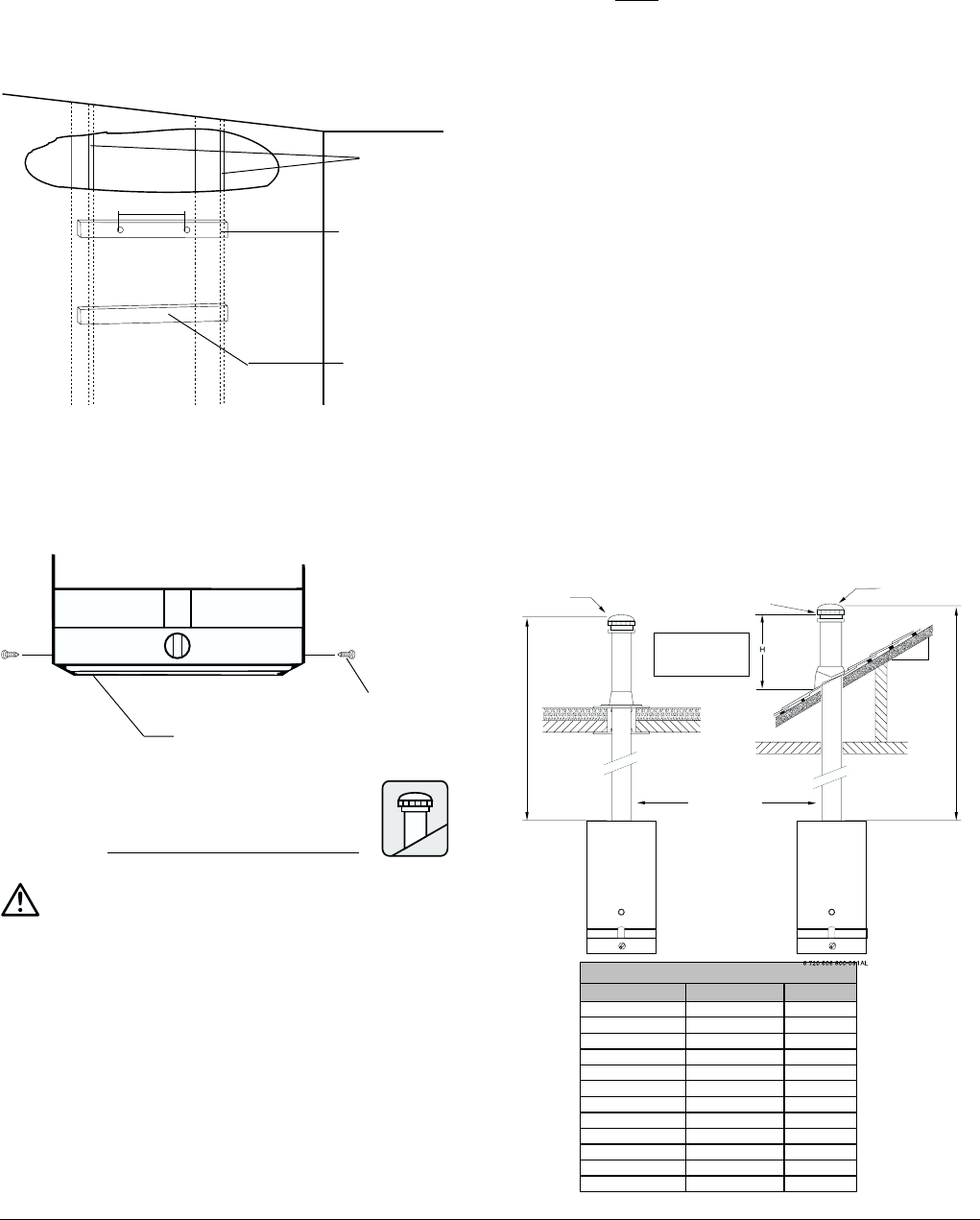
76 720 606 804
VENTING
Vent pipe connection.
WARNING: Do not reduce the vent pipe size. See Fig. 4
for high altitude installations
The heater must be vented to the outside following all local
ordinances and specifications for installing a gas appliance
vent or chimney. The heater must be located as close as
practicable to a vertically rising chimney or vent that has a
listed vent cap at its termination point. The venting system
must be designed and constructed so as to develop a posi-
tive flow adequate to remove flue gasses to the outdoors.
Consult the National Fuel Gas Code if the vent will have
elbows or share venting with another natural draft
Roof pitch H (minimum) feet meters
Flat to 6/12 1.0 0.30
6/12 to 7/12 1.25 0.38
Over 7/12 to 8/12 1.5 0.46
Over 8/12 to 9/12 2.0 0.61
Over 9/12 to 10/12 2.5 0.76
Over 10/12 to 11/12 3.25 0.99
Over 11/12 to 12/12 4.0 1.22
Over 12/12 to 14/12 5.0 1.52
Over 14/12 to 16/12
6.0 1.83
Over 16/12 to 18/12 7.0 2.13
Over 18/12 to 20/12 7.5 2.27
Over 20/12 to 21/12 8.0 2.44
GAS VENT TERMINATIONS FOR LISTED VENT CAPS
Listed vent cap
Lowest discharge
opening
H (minimum) height
from roof to lowest
discharge opening
Roof Pitch
IS X/12
12
X
Listed gas vent
Figure A Figure B
Establish a one foot
rise before any elbows
MINIMUM 6 FEET (1.8M)
Listed vent cap
plasterboard, can cause failure of mounting.
In earthquake-prone zones, CEC recommends that installers
use a large washer and lag screw through the existing holes
used to hang the heater to affix the upper third of the heater
to the mounting board. To affix the lower third of the heater,
CEC recommends that two new holes be drilled in the
heater’s frame, each one 16 inches below the top two holes,
and that washers and lag screws be used to secure the
lower portion of the heater to a spacing board.
Before installing the unit, be certain you have the correct
heater for your type of Gas – Propane or Natural Gas.
Identification labels are found on the shipping box, and on
the rating plate which is located on the right side panel of
the cover. Also, each burner orifice is stamped with a number
(79 for LPG and 120 for Natural Gas).
Fig. 2 - Mounting the Heater
WALL STUDS
1” X 4”
SPACE BOARD
SUPPORT
BOARD
13 ¼”
Fig. 3 - Incandescent Particle Tray Illustration
The incandescent particle tray (shipped loose in the carton
with the water heater) must be attached at the bottom of
the water heater front cover at the time of installation. Use
the screws provided. See figure 3
SCREWS
INCANDESCENT PARTICLE TRAY
appliance. The heater should never be common vented
with a mechanically vented appliance. Single wall vent
pipe is not recommended, if used consult the National
Fuel Gas Code.
Horizontally venting to a sidewall vent terminator or a
vertically constructed vent stack along an outside wall of a
building is not permissible. A Powervent (Model AQ-1), with
a proof-of-draft safety interlock device, is required and is
available in order to sidewall vent. Contact your dealer. In
the Commonwealth of Massachusetts: Powervented
applications must utilize proof-of-draft safety interlock
device.
VERTICAL GAS VENT: A 5 inch diameter gas vent constructed
of double wall Type B gas vent is recommended. 6 inch is
required in elevations greater than 2000 feet, see Fig. 4.
Any gas vent section that is greater than 45 degrees from
the vertical is considered horizontal. Horizontal sections must
slope upwards at least ¼ inch for every foot of its horizontal
length and be properly supported. Keep the horizontal section
short and avoid too many elbows. The minimum vertical gas
vent height allowed is 6 feet; horizontal vent connectors
and elbows are not to be considered in the total gas vent
height. All gas vent sections must be secured to each other
with sheet metal screws and be properly supported.
The gas vent constructed of double wall Type B gas vent
must terminate above the roof surface with a listed vent
cap at a height that’s in accordance with Figure A or B and
their table, provided they are at least 8 feet (2.4 m) from a
vertical wall or similar obstruction. All other gas vents that
are not able to terminate within the minimum specified height
allowed must terminate not less than 2 feet (0.6 m) above
the highest point where it’s passed through the roof and at
least 2 feet (0.6 m) higher than any vertical wall or similar
obstruction within 10 feet (3.1 m).


















